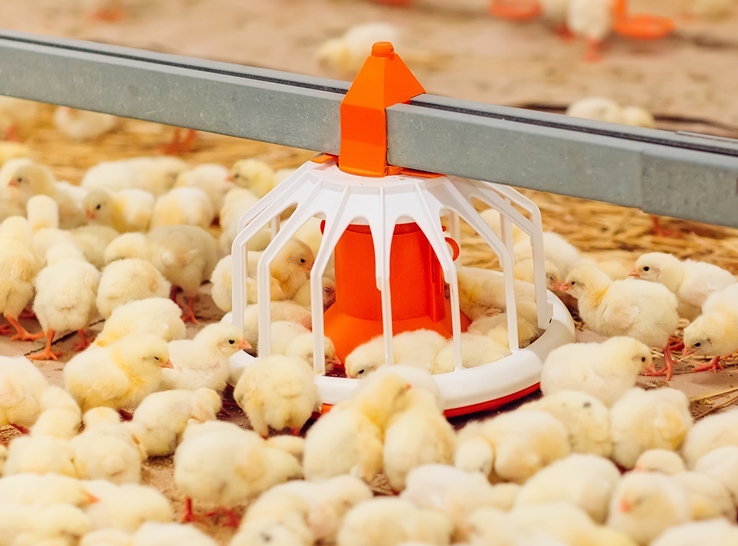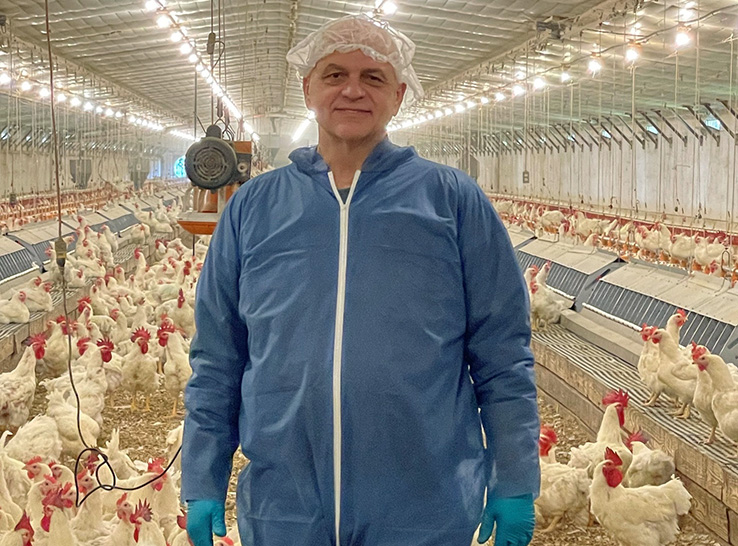By W.A. Dozier, III, PhD
Department of Poultry Science
Auburn University and Alabama Cooperative Extension System
Integrated poultry operations have experienced improved metrics related to broiler performance over the past few years. The advancement in genetic selection of parent stock has translated to annual improvements with progeny of approximately 45 grams of bodyweight (BW) at 2.4 kg, a 2-point decrease in cumulative feed conversion and a 0.17% increase in breast-meat yield.
The improvement of genetic selection has also resulted in an increased appetite of cockerels and pullets, creating challenges with feed management and leading to poor uniformity during rearing. Uniformity of pullets and cockerels can be affected by brooding management, feeder space, stocking density, feed distribution and feed-allocation programs.
Brooding
It is important to get chicks off to a good start by ensuring proper feed and water access and meeting temperature setpoints during brooding. Additionally, it is necessary to provide an optimal brooding environment to achieve target BW and frame development during the first 4 weeks of age.
With preplacement, house sanitation is the key to maintaining pullet livability. Litter depth should be 4 to 6 inches throughout the house. Obtaining a uniform depth of litter or bedding materials is critical for absorbing moisture and maintaining litter quality throughout the house.
At placement, ensure that the boxes in the brood area are evenly distributed in a line. Chicks should have easy access to feed and water, with supplemental feeders and waterers on paper in the brood area for 3 to 4 days. It is recommended to place a temporary fence from the sidewall to the other side of nipple waterers, providing chicks with easy access to feed and water (Figure 1). Additionally, supplemental feeders and waterer trays should be provided, allowing for approximately 50 birds per tray, which is dependent upon the size of the trays.

Figure 1. A brooding setup that provides chicks with access for feed and water consumption optimizes growth during the first few days postplacement.
The success of brooding can be assessed with crop-fill scoring. It is necessary to determine the percentage of chicks consuming feed and water by monitoring crop fill. Crop-fill scores can be determined with 10 birds per location, with four locations throughout the house.
Chicks can be scored at 2, 8, 12, 24 and 48 hours after placement, with 95% of the chicks having a category 1 score (full, soft and rounded) at 24 hours and 100% of the chicks at 48 hours after placement.1 Scores of categories 2 and 3 represent chicks having crops with hard feed residue but little or no water and no feed apparent in the crop.
Uniformity
A uniform flock is easier to manage for feed allocation, target BW and adequate fleshing (males only) to optimize reproductive performance during the life of the flock.
Underweight birds typically respond more slowly to light stimulation. Lower BW hens are known to produce smaller eggs and have lower hatchability, resulting in increased embryonic mortality early in the lay cycle. It is important to achieve target BW and uniformity by 9 weeks of age (WOA) and feed birds to meet target BW from 15 to 21 WOA for sexual maturity.
Uniformity is calculated by the coefficient of variation percentage and/or evenness (percentage of birds within 10% of the average BW). Ideally, 50 birds should be weighed weekly at three or four locations in the house. Platforms can obtain weights of 600 to 900 birds daily. These scales are popular due to reduced labor requirements and daily weights; they also allow for quick changes in feed allocation and provide consistent data.
It is good to hand-weigh birds in multiple locations to verify that the platform scales are providing an accurate representation of the BW of the whole house. In addition, shank length has a strong relationship with BW and keel length. Lighter cockerels will tend to have shorter shank lengths. The target BW should be met early in life, as it will impact the skeletal frame size of male parent stock. Approximately 71% of the shank length at 25 WOA of males can be achieved by 8 WOA.
Potential causes of poor uniformity in cockerels include unlevel floors, insufficient feeder space and floor space, improper feed distribution and health issues. Longer shanks and keels are an advantage for males to complete matings in the breeder house. Pullet uniformity is primarily related to insufficient feeder space, incorrect feed distribution and health issues.
Grading
Cockerels are being graded during rearing in some locations in the US to improve uniformity and reduce the proportion of lighter BW males before moving to the lay house.
Grading is a sorting technique to separate birds by BW during rearing. It allows birds to have different feed allocation based on their BW to improve body condition, frame development, uniformity and sexual maturity. This has been practiced in the US primarily with cockerels.
Grading can consist of either two-way, three-way, or four-way grading, which involves separating the population into various weight ranges. It is typically conducted at 4 and 8 WOA but can be performed again at 12 WOA if labor constraints and cost are not prohibitive factors.
After grading, it is important to determine the correct feed allocation for the various BW groups. Each subpopulation needs adequate feeder and water space when the house is divided into separate pens.
Also, it is essential to be able to feed the BW groups separately. This will require additional bins, fill lines and hoppers. The light BW group tends to consume feed more slowly than the dominant birds that were in the population before grading.
Feeding-behavior dynamics need to be considered when feeding the light BW group after the first week of grading at 4 WOA. After grading at 4 WOA, the BW curve may need to be reassessed so that the target BW is reached at 8 WOA. It is also important to obtain proper skeletal development; a longer keel helps distribute fleshing so that males do not become over-fleshed during lay.
Space needs
Feeder space is typically adequate during the first phase of rearing but can become limited later in rearing. It varies with age, and using track and pan feeders.
A reduction in feeder space prevents all birds in the house from having enough space to consume feed simultaneously and can result in BW variation. Insufficient feeder and floor space can also lead to issues related to nervousness and piling, increased feather picking and licking, increased leg abnormalities, gastrointestinal and other related health problems, and increased culling with low BW and poor frame development.
Strategies to improve feeder space include adding a line of pan feeders or a loop of track feeders. Be careful not to add too much feeder space, as this can result in exceeding the target BW.
Pullet flocks may exceed feeder space by 12 or 13 WOA. Houses equipped with an adequate number of pan feeders can accommodate 11 to 12 pullets per pan, but it is common to observe houses providing feeder space for 15 to 16 pullets per pan (Figure 2). Houses for cockerels should be equipped with pans to accommodate eight to nine birds per pan.
Insufficient feeder space can impact both BW and shank-length uniformity. Also, the space between adjacent pans can limit feed access. During late rearing, birds consuming feed from one pan can limit access to the adjacent pan. Hence, there may not be adequate space for all birds in the house (Figure 3). Birds need approximately 6 linear inches of feeder space with trough feeders and 4 inches with pan feeders late in rearing.

Figure 3. Inadequate space between pans leads to inadequate feeder space to optimize nutrient intake for all pullets in the house.
Mejia and Semon (2024) presented a scenario of 18,518 pullets placed in a 40 x 500 ft house (1.35 ft2/bird) to illustrate the impact of feeder space in pullet houses.2 If the house was equipped with three loops of a chain-feeding system, this would provide only 3.88 inches per bird. The same house equipped with four loops of a chain-feeding system would translate to 5.18 inches per bird. The same number of pullets placed in the exact same house dimensions equipped with five feeder-pan lines (1,000 pans) translates to 18.5 birds/pan. If six lines of pans (1,200) were used in the same setup, this would translate to 15.4 birds/pan. These calculations demonstrate the need to determine the feeder-space capacity within a complex. A typical house setup may not provide the amount of feeder space that you may assume.
Floor space needed to meet target BW and uniformity can vary between males and females during rearing. Floor space for pullets typically ranges from 1.35 to 1.50 ft2/bird. Stocking density of pullets at 1.6 ft2/bird can provide more feeder space with a range of 11 to 12 birds per pan. Conversely, the floor space of cockerels is typically in the range of 2.5 to 3.0 ft2/bird.
Poor uniformity of males has been observed in the field with tighter floor densities approximating 1.9 ft2/bird. These densities may occur with a limited number of facilities in which to rear males and females separately. Floor space of males should range from 2.8 to 3.0 ft2/bird, but the amount of feeder space needs to be considered as well. Companies may need to provide additional floor space (3.25 ft2/bird) to achieve the proper feeder space for cockerels to optimize uniformity and skeletal development.
Feed distribution
Birds need to have access to feed throughout the house so that all birds can consume feed simultaneously. Feed should be distributed in less than 3 minutes.
One of the biggest challenges in feed distribution is feed density. Also, uneven feed distribution significantly impacts nutrient intake. The use of diluents or fibrous feedstuffs to create enough volume is central to feed distribution. It is essential to understand the variation of nutrient composition of fibrous sources to avoid inadequate amino acid and energy intake. This can influence the target BW during rearing.
Feed delivery of a chain-feeding system is influenced by the length of the house and chain speed. Chain speed can impact feed distribution in larger houses. The chain-feeding system has worked well in small houses (36 feet x 300 feet) with a chain speed of 60 feet per minute. Larger houses (40 feet x 500 feet) require a faster chain speed of 90 feet per minute to distribute feed uniformly in a short time. If feed is not being distributed quickly with a chain-feeding system, adding hoppers, feed lines and loops can improve feed-line distribution.
The feeder-pan system has its unique management opportunities. Equipment failure can be one of the biggest obstacles for feed distribution with a pan-feeding system. Pan feeders lose charge (inadequate amount of feed in the pan) when motors trip and switches fail to operate. Despite the risk of equipment failure, it is important that all birds have access to feeder pans. Be aware that low areas on the floor make it difficult for pullets to access pan feeders.
In addition to feed distribution, the correct feed amounts must be delivered to feed hoppers to meet target BW gains, skeletal development and uniformity. Feed-bin scales should be routinely calibrated to ensure the correct amount of feed is being distributed.
Feeding programs
Feed volume is central to having adequate feed distribution during rearing. Reducing the energy density of the diet in the range of 1,200 to 1,220 kcal/pound can be considered to enhance feed distribution.
Fiber inclusion
Decreasing energy by increasing the inclusion of fibrous ingredients can help increase feed volumes, but it depends on the type of fiber source. Fiber sources vary in energy and amino acid density, and the specific fiber source can dictate the reduction in energy achieved through diet formulation.
Fibrous ingredient sources can vary widely in energy and amino acid content. It is recommended to monitor the crude protein and fiber variability of these feedstuffs. Be aware that it may be difficult to source a consistent supply of these ingredients to obtain high inclusion rates to reduce energy density. Additionally, adequate storage at the mill can also present challenges for some locations.
Feed restriction
Feed-restriction programs can consist of skip-a-day, 4-3, 5-2, 6-1 or every-day feeding. Feed restriction is necessary to minimize excessive BW gain and fleshing and prevent reproductive issues. Skip-a-day feeding programs provide feed distribution, are easy to implement and achieve good results with BW uniformity. Also, longer cleanup times are beneficial, allowing smaller birds time to consume feed to meet their nutrient requirements.
Every-day feeding has received attention due to welfare concerns with skip-a-day feeding. Hunger anxiety can occur with skip-a-day or 4-3 feeding programs. Every-day feeding of pullets has been cited to help alleviate welfare concerns. High-density feed ingredients coupled with older equipment can cause feed distribution challenges with every-day feeding. Remember that higher inclusion of fibrous ingredients is necessary for every-day feeding to achieve low dietary energy.
Sweeney et al. evaluated every-day feeding and skip-a-day feeding of Ross 708 pullets on subsequent reproductive performance during the lay cycle.3 At 20 WOA, every-day-fed pullets had more uniform BW than skip-a-day fed pullets (11.2% versus 15.8%). Every-day-fed birds exhibited improvements in early lay, eggshell quality and increased egg weight during the lay cycle.
The logistics of implementing every-day feeding (higher dietary-fiber diets) will need to be evaluated in commercial practice in the US.
Summary
- Genetic selection has resulted in improved growth rate and nutrient utilization of broilers. This improvement has led to an increased appetite of pullets and cockerels.
- These increased performance metrics with broilers have placed a demand on enhanced management with broiler breeders to increase hatchability. Perhaps in the future, improved feeder management (presentation feeding) should be evaluated during the rearing phase to improve feed distribution.
- Feeder space, feed distribution, floor space and feed management are central to improving the management of uniformity during rearing. In addition, implementing grading and properly managing the flock after grading are very important to ensuring a uniform flock.
- Uniformity of BW and frame development during rearing is essential in obtaining performance objectives during lay with breeders.
References
- Aviagen Arbor Acres Parent Stock Management Handbook. 2023. https://aviagen.com/assets/Tech_Center/AA_Breeder_ParentStock/Aviagen_ArborAcres_PS_Handbook_2023_Interactive_EN.pdf
- Mejia and Semon. Feed management practice in rearing and lay for males and females. Auburn University Pullet and Broiler Breeder Conference 2024.
- Sweeney KM, Aranibar CD, Kim WK, Williams SM, Avila LP, Starkey JD, Starkey CW, Wilson JL. Impact of every-day versus skip-a-day feeding of broiler breeder pullets during rearing on body weight uniformity and reproductive performance. Poult Sci. 2022 Aug;101(8):101959. Epub 2022 May 13.
Editor’s note: The views expressed in this article are solely those of the author.








